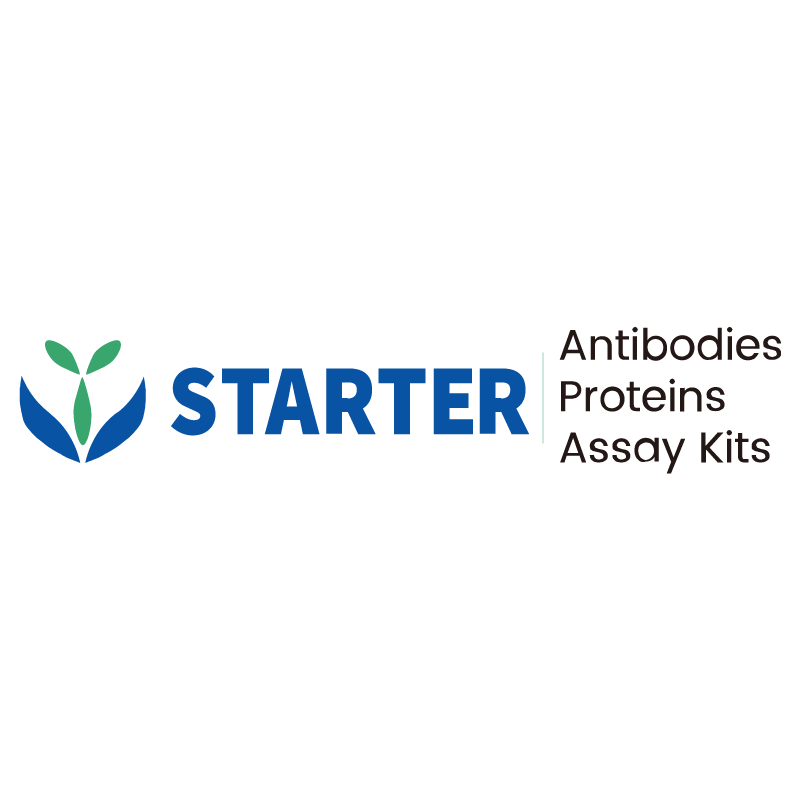WB result of AP2α Recombinant Rabbit mAb
Primary antibody: AP2α Recombinant Rabbit mAb at 1/1000 dilution
Lane 1: HepG2 whole cell lysate 20 µg
Lane 2: SK-BR-3 whole cell lysate 20 µg
Lane 3: T-47D whole cell lysate 20 µg
Lane 4: HeLa whole cell lysate 20 µg
Lane 5: 293T whole cell lysate 20 µg
Low expression control: HepG2 whole cell lysate
Secondary antibody: Goat Anti-rabbit IgG, (H+L), HRP conjugated at 1/10000 dilution
Predicted MW: 48 kDa
Observed MW: 48 kDa
This blot was developed with high sensitivity substrate
Product Details
Product Details
Product Specification
| Host | Rabbit |
| Antigen | AP2α |
| Synonyms | Transcription factor AP-2-alpha; AP2-alpha; AP-2 transcription factor; Activating enhancer-binding protein 2-alpha; Activator protein 2 (AP-2); AP2TF; TFAP2; TFAP2A |
| Immunogen | Synthetic Peptide |
| Location | Nucleus |
| Accession | P05549 |
| Clone Number | S-2376-7 |
| Antibody Type | Recombinant mAb |
| Isotype | IgG |
| Application | WB, IHC-P, ICC |
| Reactivity | Hu, Ms, Rt |
| Positive Sample | SK-BR-3, T-47D, HeLa, 293T |
| Purification | Protein A |
| Concentration | 0.5 mg/ml |
| Conjugation | Unconjugated |
| Physical Appearance | Liquid |
| Storage Buffer | PBS, 40% Glycerol, 0.05% BSA, 0.03% Proclin 300 |
| Stability & Storage | 12 months from date of receipt / reconstitution, -20 °C as supplied |
Dilution
| application | dilution | species |
| WB | 1:1000 | Hu |
| IHC-P | 1:250 | Hu, Ms, Rt |
| ICC | 1:500 | Hu |
Background
AP2α (Activating Protein-2α) is a nuclear transcription factor belonging to the AP-2 family, which specifically binds to DNA and regulates gene expression. It plays a critical role in various biological processes, including embryonic development, cell proliferation, apoptosis, tumor suppression, and immune regulation. The AP2α protein structure consists of an N-terminal proline- and glutamine-rich (P/Q-rich) transactivation domain, a central basic region, and a highly conserved C-terminal helix-span-helix motif responsible for DNA binding and protein dimerization. Studies have shown that AP2α acts as a tumor suppressor in multiple cancers (e.g., gastric, colorectal, and liver cancers) by regulating downstream target genes (such as p21, caspase family members, and EGF receptor) to inhibit tumor cell proliferation and promote apoptosis. Additionally, AP2α is involved in metabolic regulation (e.g., lipid synthesis) and inflammatory responses. For instance, in atherosclerosis, it upregulates IkBα expression via the AMPK signaling pathway to suppress vascular inflammation. In immunity, AP2α has been found to be significantly upregulated (particularly in the liver) in yellow croaker (Larimichthys crocea) in response to Vibrio harveyi infection, indicating its role in innate immune defense. Dysregulated expression or dysfunction of AP2α is associated with various diseases, making it a potential diagnostic biomarker and therapeutic target.
Picture
Picture
Western Blot
Immunohistochemistry
IHC shows positive staining in paraffin-embedded human kidney. Anti- AP2α antibody was used at 1/250 dilution, followed by a HRP Polymer for Mouse & Rabbit IgG (ready to use). Counterstained with hematoxylin. Heat mediated antigen retrieval with Tris/EDTA buffer pH9.0 was performed before commencing with IHC staining protocol.
IHC shows positive staining in paraffin-embedded human placenta. Anti- AP2α antibody was used at 1/250 dilution, followed by a HRP Polymer for Mouse & Rabbit IgG (ready to use). Counterstained with hematoxylin. Heat mediated antigen retrieval with Tris/EDTA buffer pH9.0 was performed before commencing with IHC staining protocol.
IHC shows positive staining in paraffin-embedded human tonsil. Anti- AP2α antibody was used at 1/250 dilution, followed by a HRP Polymer for Mouse & Rabbit IgG (ready to use). Counterstained with hematoxylin. Heat mediated antigen retrieval with Tris/EDTA buffer pH9.0 was performed before commencing with IHC staining protocol.
IHC shows positive staining in paraffin-embedded human breast cancer. Anti- AP2α antibody was used at 1/250 dilution, followed by a HRP Polymer for Mouse & Rabbit IgG (ready to use). Counterstained with hematoxylin. Heat mediated antigen retrieval with Tris/EDTA buffer pH9.0 was performed before commencing with IHC staining protocol.
IHC shows positive staining in paraffin-embedded mouse colon. Anti- AP2α antibody was used at 1/250 dilution, followed by a HRP Polymer for Mouse & Rabbit IgG (ready to use). Counterstained with hematoxylin. Heat mediated antigen retrieval with Tris/EDTA buffer pH9.0 was performed before commencing with IHC staining protocol.
IHC shows positive staining in paraffin-embedded mouse kidney. Anti- AP2α antibody was used at 1/250 dilution, followed by a HRP Polymer for Mouse & Rabbit IgG (ready to use). Counterstained with hematoxylin. Heat mediated antigen retrieval with Tris/EDTA buffer pH9.0 was performed before commencing with IHC staining protocol.
IHC shows positive staining in paraffin-embedded rat kidney. Anti- AP2α antibody was used at 1/250 dilution, followed by a HRP Polymer for Mouse & Rabbit IgG (ready to use). Counterstained with hematoxylin. Heat mediated antigen retrieval with Tris/EDTA buffer pH9.0 was performed before commencing with IHC staining protocol.
Immunocytochemistry
ICC shows positive staining in SKBR-3 cells (top panel) and negative staining in HepG2 cells (below panel). Anti-AP2α antibody was used at 1/500 dilution (Green) and incubated overnight at 4°C. Goat polyclonal Antibody to Rabbit IgG - H&L (Alexa Fluor® 488) was used as secondary antibody at 1/1000 dilution. The cells were fixed with 100% ice-cold methanol and permeabilized with 0.1% PBS-Triton X-100. Nuclei were counterstained with DAPI (Blue). Counterstain with tubulin (Red).


